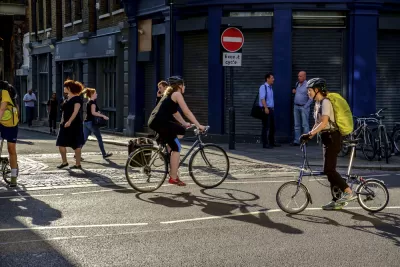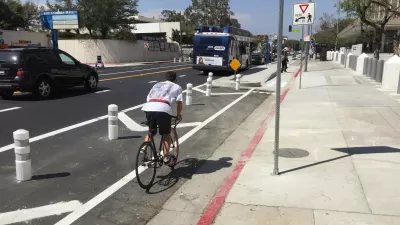Research from Europe shows bike infrastructure doesn't add to urban traffic and can shift mode share from cars to bikes and reduce the need for solo car trips.

Despite claims that cycle lanes added during the pandemic contributed to an increase in London's traffic congestion, research shows the city's traffic was largely the same in 2021 as in 2019, before the bike lanes were installed. David Metz reports that cycle lanes actually reduce the share of trips taken by car, which could diminish congestion as well. Thanks in part to aggressive measures taken by the city to discourage car trips, the use of private transport in London fell from 48 percent to 37 percent between 2000 and 2019.
"It’s important to note that creating cycle lanes reduces the space available for cars but does not necessarily get people out of cars. Copenhagen is a city famous for cycling, with 28 percent of journeys made by bike. Yet car traffic is only slightly less than in London." Meanwhile, residents of Copenhagen take only half as many public transit trips as Londoners. In fact, "there are no major European cities with high levels of both cycling and public transport. "
With revenues from public transit ridership drastically reduced by the pandemic, Metz writes, it is investments in cycling infrastructure that would "make the most sense for reducing car use in London."
FULL STORY: Why Cycle Lanes Aren’t Responsible for Urban Congestion

Trump Administration Could Effectively End Housing Voucher Program
Federal officials are eyeing major cuts to the Section 8 program that helps millions of low-income households pay rent.

Planetizen Federal Action Tracker
A weekly monitor of how Trump’s orders and actions are impacting planners and planning in America.

Ken Jennings Launches Transit Web Series
The Jeopardy champ wants you to ride public transit.

California Invests Additional $5M in Electric School Buses
The state wants to electrify all of its school bus fleets by 2035.

Austin Launches $2M Homelessness Prevention Fund
A new grant program from the city’s Homeless Strategy Office will fund rental assistance and supportive services.

Alabama School Forestry Initiative Brings Trees to Schoolyards
Trees can improve physical and mental health for students and commnity members.
Urban Design for Planners 1: Software Tools
This six-course series explores essential urban design concepts using open source software and equips planners with the tools they need to participate fully in the urban design process.
Planning for Universal Design
Learn the tools for implementing Universal Design in planning regulations.
Ada County Highway District
Clanton & Associates, Inc.
Jessamine County Fiscal Court
Institute for Housing and Urban Development Studies (IHS)
City of Grandview
Harvard GSD Executive Education
Toledo-Lucas County Plan Commissions
Salt Lake City
NYU Wagner Graduate School of Public Service





























